Did you know that Saint Vincent and the Grenadines, located in the Eastern Caribbean, is home to a staggering variety of plant and animal species? This small island nation, encompassing lush rainforests, pristine marine ecosystems, and unique sacred natural sites, holds an astounding abundance of biodiversity. However, the fragile ecosystems of Saint Vincent and the Grenadines face numerous threats that require urgent conservation efforts.
Key Takeaways:
- Saint Vincent and the Grenadines is known for its diverse range of plant and animal species, making it a biodiversity hotspot in the Caribbean.
- The country faces threats to its biodiversity, including habitat loss, invasive species, unsustainable practices, and climate change impacts.
- Conservation efforts in Saint Vincent and the Grenadines include the establishment of protected areas, the National Biodiversity Strategy and Action Plan, and initiatives to promote sustainable development.
- Forest and marine conservation play crucial roles in preserving the biodiversity of the country.
- Indigenous beliefs and traditional knowledge contribute to biodiversity conservation in Saint Vincent and the Grenadines.
Biodiversity in Saint Vincent and the Grenadines
Saint Vincent and the Grenadines is a treasure trove of biodiversity, boasting a diverse range of animal and plant species. The country’s vibrant ecosystems are home to an array of fascinating creatures and unique flora. Let’s explore the rich biodiversity that thrives in this beautiful Caribbean nation.
Animal Species
The animal kingdom in Saint Vincent and the Grenadines is a kaleidoscope of diversity. The country boasts 17 mammal species, including the charming Vincentian fruit bat and the elusive opossum. Bird enthusiasts will delight in the presence of over 190 bird species, two of which are island endemics, lending an air of exclusivity to the avian population. Reptile enthusiasts can encounter 21 reptile species, with five of them being found nowhere else in the world. Amphibians add to the enchantment, with four species that include the endemic St. Vincent black lizard.
“The biodiversity of Saint Vincent and the Grenadines is a testament to nature’s ingenuity and the delicate balance of ecosystems.”
Plant Species
The lush landscapes of Saint Vincent and the Grenadines are adorned with an extraordinary variety of flowering plants. Over 1,150 species of flowering plants thrive in this tropical haven, including 16 species that are unique to the islands. These endemic plants contribute to the country’s exceptional biodiversity and add charm to its natural habitats. The extraordinary range of plant life includes vibrant orchids, exotic bromeliads, and towering forest giants that blanket the land in a tapestry of vivid colors.
The Importance of Biodiversity
The biodiversity found in Saint Vincent and the Grenadines is not just a spectacle to behold; it also plays a crucial role in maintaining the health and stability of the country’s ecosystems. The interconnectedness of species and their habitats supports essential ecosystem services, such as pollination, water purification, and nutrient cycling. In addition, diverse plant species provide timber, medicine, and other valuable resources that contribute to the well-being of local communities.
It is imperative that we recognize the importance of preserving and protecting the biodiversity of Saint Vincent and the Grenadines. By doing so, we ensure the continued existence of these remarkable animal and plant species, as well as the resilience of the ecosystems on which we all depend.
| Animal Groups |
Number of Known Species |
| Mammals |
17 |
| Birds |
190 (2 endemics) |
| Reptiles |
21 (5 endemics) |
| Amphibians |
4 (1 endemic) |
| Flowering Plants |
Number of Known Species |
| Total |
Over 1,150 (16 endemics) |
Threats to Biodiversity in Saint Vincent and the Grenadines
Saint Vincent and the Grenadines, a country renowned for its diverse ecosystems and rich biodiversity, faces several critical threats that jeopardize its natural heritage. These threats, including habitat loss and fragmentation, invasive species, unsustainable practices, and the impacts of climate change, pose significant challenges to the survival of numerous species and the overall health of the environment.
Habitat Loss and Fragmentation
Habitat loss is a major concern in Saint Vincent and the Grenadines, resulting from deforestation, urbanization, and the conversion of natural areas for agriculture and infrastructure development. As pristine habitats are cleared or fragmented, the native species that depend on these ecosystems face displacement and struggle to find suitable niches for survival.
Invasive Species
The introduction of invasive species, both terrestrial and marine, has had devastating consequences for Saint Vincent and the Grenadines’ unique biodiversity. Invasive species outcompete native plants and animals for resources, disrupt the delicate ecological balance, and undermine the survival of indigenous species. Controlling and eradicating these invaders is an ongoing challenge for conservation efforts.
Unsustainable Practices
Unsustainable practices such as deforestation, overfishing, and destructive agricultural practices pose significant threats to Saint Vincent and the Grenadines’ biodiversity. Deforestation leads to permanent habitat loss, while overfishing depletes fish populations and disrupts marine ecosystems. Additionally, unsustainable agricultural practices, including the excessive use of pesticides and fertilizers, contribute to water pollution and the degradation of natural habitats.
Climate Change
The impacts of climate change, including rising temperatures, sea-level rise, and extreme weather events, are exacerbating the threats faced by Saint Vincent and the Grenadines’ biodiversity. Climate change disrupts the delicate balance of ecosystems, alters habitats, and affects the reproduction and migration patterns of many species. These changes can lead to reduced species diversity, increased vulnerability to diseases, and potential extinction risks.
Conservation efforts are essential to address these threats and protect the unique biodiversity of Saint Vincent and the Grenadines. By implementing sustainable land-use practices, promoting invasive species management, and mitigating the effects of climate change, we can safeguard the country’s ecosystems for future generations.

“The threats facing Saint Vincent and the Grenadines’ biodiversity require urgent action and collaboration between government agencies, conservation organizations, and local communities. By working together, we can ensure the preservation of this precious natural heritage.” – Dr. Anna Thompson, Conservation Biologist
Conservation Efforts in Saint Vincent and the Grenadines
Saint Vincent and the Grenadines is actively implementing various conservation efforts to protect its diverse biodiversity. The country has created a network of protected areas that include wildlife reserves, marine conservation areas, forest reserves, and marine parks. These protected areas serve as havens for a wide range of habitats and species, safeguarding their survival and promoting their ecological stability.
The National Biodiversity Strategy and Action Plan (NBSAP) is a crucial guiding document that outlines the country’s conservation priorities and strategies. It establishes a roadmap for the effective implementation of conservation measures, focusing on sustainable development practices and resource management.
The NBSAP in Saint Vincent and the Grenadines emphasizes the importance of promoting sustainable land use practices to minimize habitat loss and fragmentation. By integrating conservation into land-use planning processes, the country aims to strike a balance between development and biodiversity protection.
To raise awareness about the value of biodiversity, the country has initiated various conservation projects and initiatives. These include educational programs, community engagement events, and public outreach campaigns. By involving local communities and stakeholders, these efforts aim to foster a sense of stewardship and responsibility for the environment.

| Conservation Initiatives |
Focus Areas |
| Establishment of Protected Areas |
Safeguarding habitats and species through the creation of wildlife reserves, marine conservation areas, forest reserves, and marine parks. |
| National Biodiversity Strategy and Action Plan |
Guiding the implementation of conservation measures, promoting sustainable development, and integrating biodiversity considerations into national planning processes. |
| Promotion of Sustainable Land Use Practices |
Minimizing habitat loss and fragmentation through the adoption of sustainable land use practices and incorporating conservation into land-use planning processes. |
| Public Awareness and Engagement |
Raising awareness about the value of biodiversity through educational programs, community engagement events, and public outreach campaigns. |
Through these conservation initiatives, Saint Vincent and the Grenadines is committed to preserving its unique natural heritage for future generations. By protecting its ecosystems and promoting sustainable development, the country strives to maintain the delicate balance between human activities and the conservation of its remarkable biodiversity.
Forest Conservation in Saint Vincent and the Grenadines
Saint Vincent and the Grenadines is home to approximately 29% tropical forest cover, encompassing various types of forests such as primary and secondary rainforests, palm brakes, elfin woodlands, and mangrove forests. These forests provide critical habitats for a diverse range of plant and animal species, contributing to the country’s rich biodiversity.
However, Saint Vincent and the Grenadines has faced the challenge of deforestation, leading to a significant decrease in forest cover from 1949 to 1993. Deforestation occurs due to various factors, including clearance for agriculture, logging, and urbanization. It poses a threat to the ecological balance and can result in the loss of valuable ecosystem services.
To address this issue, Saint Vincent and the Grenadines has implemented forest conservation strategies aimed at preserving and restoring its forests. Reforestation initiatives have been undertaken to replant and regenerate areas that have been cleared, allowing for the regrowth of trees and the recovery of forest ecosystems.
Conservation forestry interventions have also been implemented to ensure the sustainable management of forests. This involves adopting practices that minimize the impact of logging and promote the regeneration of trees, thereby preserving forest ecosystems and their biodiversity.
The conservation of forests in Saint Vincent and the Grenadines is crucial for the preservation of wildlife and the country’s natural heritage. Forests provide habitats for numerous species, including endangered and endemic plants and animals. They also contribute to the regulation of climate, water resources, and soil conservation.
| Benefits of Forest Conservation in Saint Vincent and the Grenadines |
| Preservation of biodiversity and protection of endangered species |
| Provision of ecosystem services, such as carbon sequestration and water regulation |
| Maintenance of soil fertility and prevention of erosion |
| Promotion of sustainable livelihoods through eco-tourism and non-timber forest products |
Efforts to conserve forests in Saint Vincent and the Grenadines are essential for the sustainable development of the country. By preserving these vital ecosystems, Saint Vincent and the Grenadines can ensure the continued provision of ecosystem services, promote biodiversity conservation, and support the well-being of local communities.
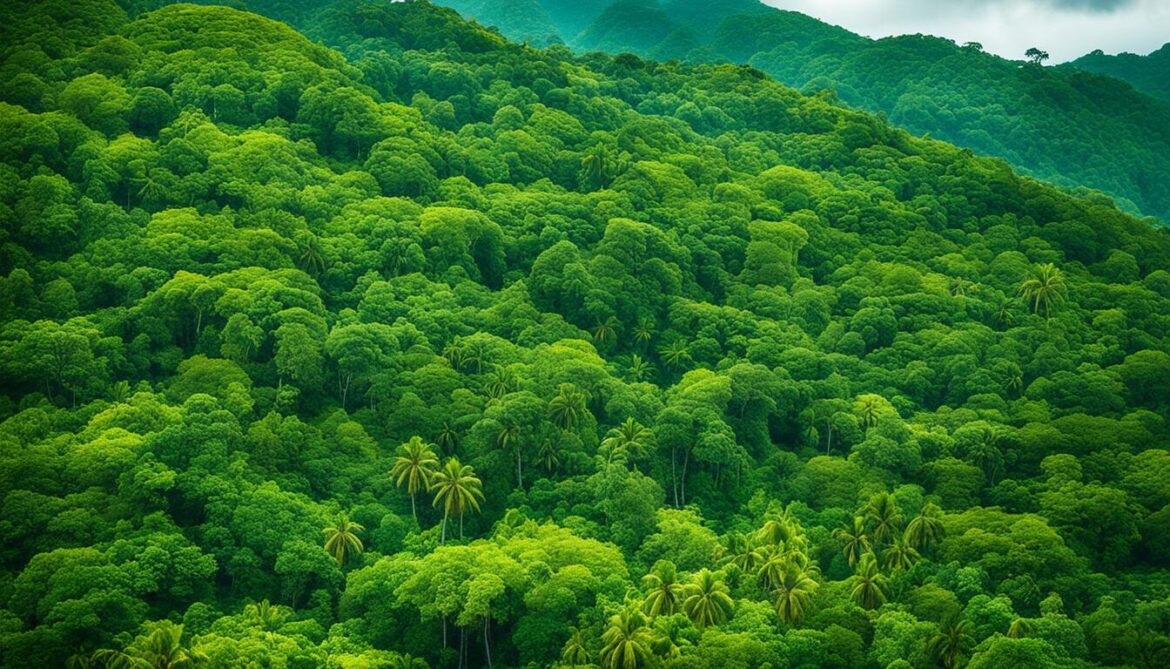
Marine Conservation in Saint Vincent and the Grenadines
Saint Vincent and the Grenadines is renowned for its diverse marine ecosystems, which are home to a wide range of species. The country has taken significant steps towards safeguarding its marine biodiversity through the establishment of marine conservation areas, marine parks, and marine reserves. These designated areas play a vital role in conserving fish species, corals, and other marine organisms, ensuring the long-term health and sustainability of the marine environment.
The marine conservation areas in Saint Vincent and the Grenadines are carefully designed to protect and manage marine ecosystems in a comprehensive and sustainable manner. These areas not only provide habitats for a variety of marine species but also support the overall health and productivity of the marine environment. By implementing strict regulations and effective management practices, marine conservation areas contribute to the preservation and conservation of marine biodiversity.
Marine parks, on the other hand, serve as designated areas specifically set aside for the conservation and protection of marine ecosystems. These parks are carefully selected to represent a range of habitats and biodiversity. They provide opportunities for scientific research, education, and recreational activities that promote awareness and appreciation of the marine environment.
The Role of Marine Parks
“Marine parks in Saint Vincent and the Grenadines play a crucial role in conserving and managing our marine resources. They serve as sanctuaries for marine life, ensuring the protection of critical habitats and vulnerable species.” – Dr. Maria Thompson, Marine Biologist
Marine parks offer a variety of benefits, including protecting vulnerable and endangered species, conserving coral reefs, and preserving nesting sites for sea turtles. These areas often feature unique geological formations and provide important feeding and breeding grounds for marine organisms.
Efforts are also underway to address the various threats faced by marine ecosystems in Saint Vincent and the Grenadines. Overfishing, coastal habitat destruction, pollution, and the impacts of climate change pose significant challenges to the health and integrity of the marine environment. Through collaborative initiatives and partnerships, the government, local communities, and environmental organizations are working together to mitigate these threats and ensure the long-term sustainability of marine ecosystems.
Marine Conservation Areas in Saint Vincent and the Grenadines
| Marine Conservation Area |
Location |
Key Features |
| Tobago Cays Marine Park |
Grenadines |
World-renowned coral reefs, seagrass beds, and turtle nesting sites |
| Kingstown Bay Marine Reserve |
Kingstown Bay |
Protection of coral reefs and marine habitats in the capital city |
| Indian Bay/Buccament Bay Marine Conservation Area |
Indian Bay and Buccament Bay |
Preservation of seagrass meadows, mangrove forests, and diverse marine life |
These marine conservation areas are just a few examples of the country’s commitment to protecting its marine biodiversity. By designating and managing these areas effectively, Saint Vincent and the Grenadines aims to ensure the long-term survival of its marine species and ecosystems for future generations to enjoy.
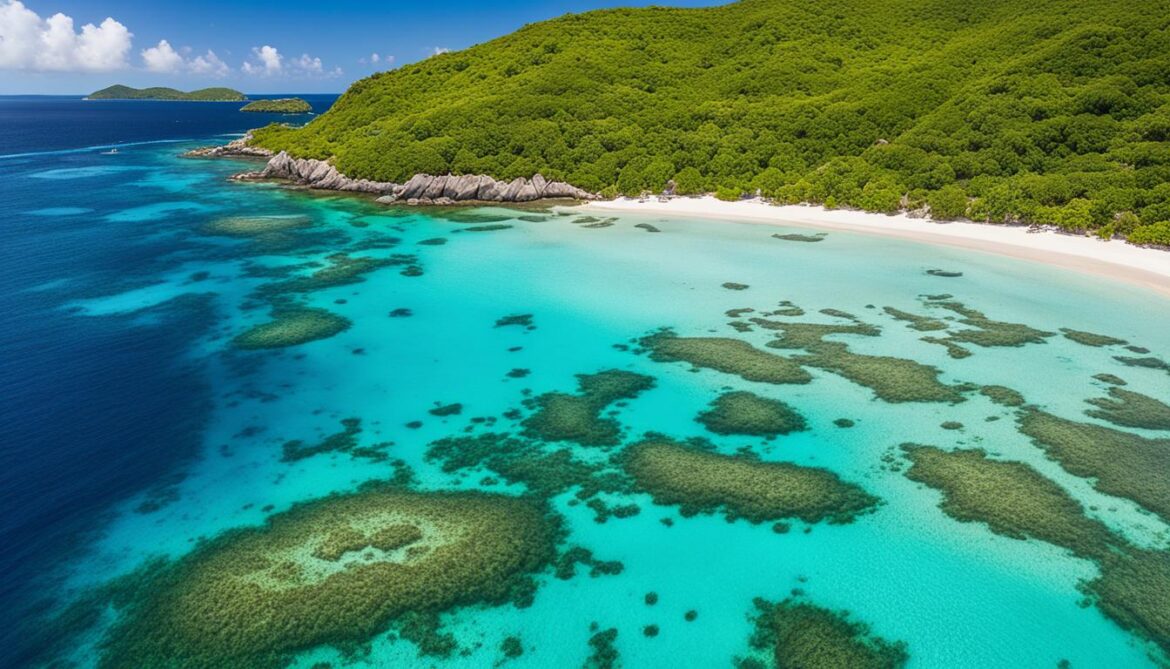
Sustainable Development and Biodiversity Conservation in Saint Vincent and the Grenadines
Saint Vincent and the Grenadines recognizes the importance of sustainable development in preserving its valuable biodiversity. The country’s commitment to conservation is evident through the implementation of the National Biodiversity Strategy and Action Plan (NBSAP). This comprehensive plan integrates biodiversity conservation into national planning processes, allowing for the sustainable use of biological resources.
With a focus on conservation measures, Saint Vincent and the Grenadines is taking significant steps to protect its diverse ecosystems and species. The country is working towards integrated natural resource management to ensure the efficient and sustainable utilization of resources. By rationalizing land use allocation, the country aims to strike a balance between economic development and the preservation of biodiversity.
Conservation at the National and Local Levels
Conservation efforts are being strengthened both at the national and local levels in Saint Vincent and the Grenadines. The NBSAP provides guidelines for protected area management and emphasizes community involvement in conservation initiatives. Local communities, with their unique knowledge of the environment, are encouraged to actively participate in biodiversity conservation.
Furthermore, the country is enhancing its capacity for sustainable biodiversity use by promoting research and monitoring programs. These initiatives help gather valuable data on species distribution, population trends, and habitat health, enabling evidence-based decision-making in conservation efforts.
“The integration of sustainable development practices and conservation measures is crucial for the long-term preservation of Saint Vincent and the Grenadines’ unique biodiversity.”
By embracing sustainable development and integrating conservation measures into its planning processes, Saint Vincent and the Grenadines aims to create a sustainable future where biodiversity thrives alongside economic growth and societal well-being. With ongoing efforts, the country is poised to protect its natural heritage and ensure the continued existence of its diverse ecosystems and species.
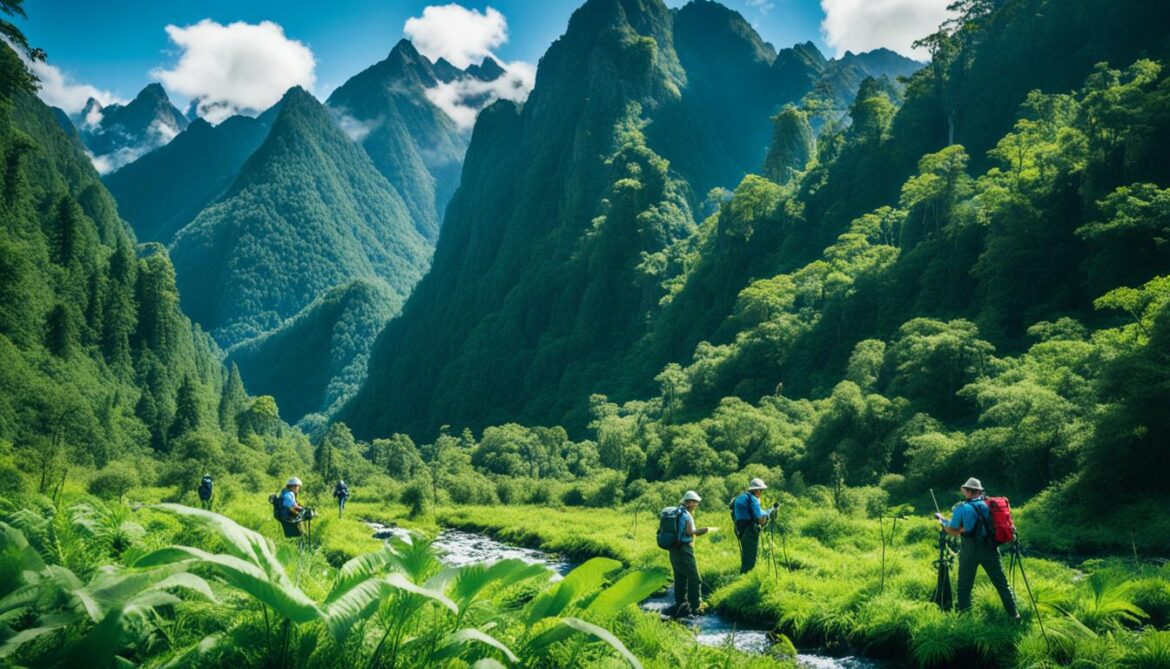
Threats to Forest and Marine Biodiversity in Saint Vincent and the Grenadines
The forest and marine biodiversity in Saint Vincent and the Grenadines face a range of threats that require immediate attention and action. These threats include limited land use planning, forest fires, overfishing, and coastal habitat destruction. Each of these factors poses a significant risk to the delicate balance of the ecosystems and the long-term conservation of species.
Limited Land Use Planning
A crucial aspect of preserving biodiversity is the careful management of land use. Unfortunately, Saint Vincent and the Grenadines currently face challenges related to limited land use planning. This can lead to unplanned urbanization, deforestation, and the degradation of important habitats. By prioritizing comprehensive land use planning, the country can mitigate these threats and ensure sustainable development that protects its valuable natural resources.
Forest Fires
Forest fires pose a severe threat to the forest biodiversity of Saint Vincent and the Grenadines. These fires can devastate large areas of forest, destroying valuable habitat and endangering numerous species. Implementing effective fire prevention measures, such as early detection systems and community awareness campaigns, is key to reducing the occurrence and impact of forest fires, safeguarding the integrity of the ecosystems.
Overfishing
Overfishing is another significant threat to the marine biodiversity of Saint Vincent and the Grenadines. Unsustainable fishing practices, driven by the demand for seafood, can deplete fish populations and disrupt the delicate balance of marine ecosystems. Implementing well-regulated fishing quotas, promoting responsible fishing practices, and establishing marine protected areas are essential strategies to prevent overfishing and protect the marine biodiversity of the region.
Coastal Habitat Destruction
The destruction of coastal habitats, such as mangroves and coral reefs, poses a grave threat to the marine biodiversity of Saint Vincent and the Grenadines. Coastal development, pollution, and climate change impacts contribute to the degradation of these critical habitats, jeopardizing the survival of numerous species. By implementing coastal management practices, promoting sustainable tourism, and raising awareness about the importance of coastal habitat conservation, the country can protect its marine biodiversity for future generations.
Efforts are needed to mitigate these threats and ensure the preservation of biodiversity in Saint Vincent and the Grenadines. By addressing limited land use planning, preventing and managing forest fires, implementing sustainable fishing practices, and protecting coastal habitats, the country can safeguard its unique ecosystems and the species that depend on them.

Indigenous Beliefs and Biodiversity Conservation in Saint Vincent and the Grenadines
Indigenous beliefs and traditional knowledge play a significant role in biodiversity conservation in Saint Vincent and the Grenadines. Local communities and indigenous peoples possess unique knowledge and practices that contribute to the sustainable use and conservation of natural resources. Their traditional practices often align with conservation goals, fostering a harmonious relationship between humans and the environment.
By recognizing and incorporating indigenous beliefs and knowledge into conservation efforts, we can enhance the effectiveness of biodiversity conservation in the country. This collaboration between traditional and scientific approaches creates a holistic and comprehensive approach to environmental protection.
Indigenous communities have a deep spiritual connection with the land and biodiversity. Their beliefs and rituals emphasize the interconnectedness of all living beings and the importance of preserving the delicate balance of nature. Through their traditional practices, they have developed sustainable resource management strategies that have stood the test of time.
Indigenous communities in Saint Vincent and the Grenadines have a wealth of knowledge on local ecosystems, medicinal plants, and sustainable farming techniques. They possess valuable insights into the relationship between human activities and the health of the environment. Integrating their knowledge and practices into conservation efforts can provide us with valuable guidance on how to mitigate the negative impacts of human activities on biodiversity.
By embracing indigenous beliefs and traditional knowledge, we can foster greater respect and understanding for the natural world. This inclusive approach not only enhances the effectiveness of biodiversity conservation but also ensures the preservation of cultural heritage and promotes social equity.
Benefits of Integrating Indigenous Beliefs and Knowledge:
- Enhanced understanding of traditional sustainable practices
- Promotion of inclusive and participatory decision-making processes
- Conservation strategies rooted in local context and culture
- Preservation of cultural heritage and traditional knowledge
- Improved community engagement and cooperation
Current Initiatives:
Several organizations and research institutions are working closely with indigenous communities in Saint Vincent and the Grenadines to integrate their beliefs and knowledge into biodiversity conservation efforts. These initiatives aim to empower local communities, preserve traditional practices, and promote sustainable land and resource management.
Example of Indigenous Conservation Practice:
| Conservation Practice |
Description |
| Sacred Natural Sites |
Indigenous communities designate specific areas as sacred natural sites, acknowledging the spiritual significance and ecological value of these places. These sites are protected and managed according to traditional beliefs and practices, ensuring the preservation of biodiversity and the continuation of cultural traditions.
|
| Traditional Farming Techniques |
Indigenous agricultural practices prioritize sustainable farming methods such as agroforestry, crop rotation, and natural pest control. These techniques promote soil health, preserve biodiversity, and minimize the use of synthetic inputs, contributing to the overall conservation of natural resources.
|
| Community-led Conservation |
Indigenous communities actively participate in conservation efforts, leading community-based initiatives to protect and restore local ecosystems. Through their traditional knowledge and practices, they serve as stewards of the land, ensuring its long-term sustainability and the conservation of biodiversity for future generations.
|
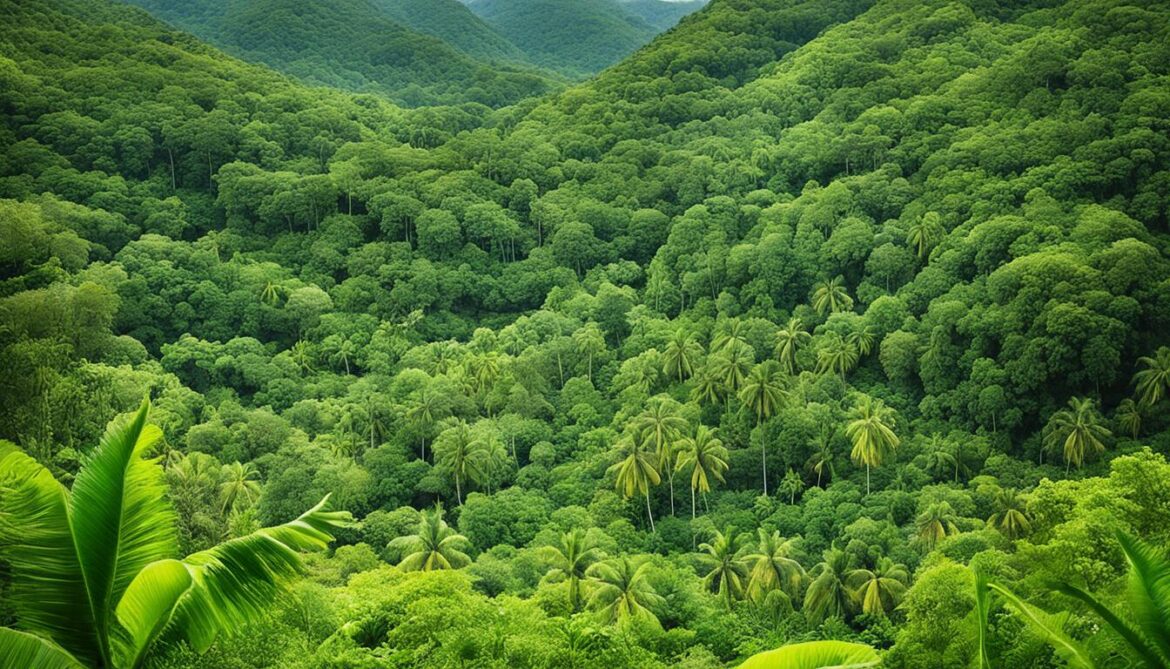
Incorporating indigenous beliefs and traditional knowledge into biodiversity conservation efforts in Saint Vincent and the Grenadines is not only essential for the long-term sustainability of ecosystems but also an opportunity to learn from and appreciate the wisdom of indigenous cultures. By recognizing the value of traditional practices and promoting collaboration between indigenous communities and conservation organizations, we can create a more inclusive and effective approach to biodiversity conservation.
Conclusion
Saint Vincent and the Grenadines is blessed with a remarkable diversity of sacred natural sites and thriving biodiversity. The country has taken significant steps to protect its precious ecosystems by establishing protected areas. However, the challenges of habitat loss, invasive species, and unsustainable practices persist, posing threats to the country’s unique biodiversity.
To ensure the long-term sustainability of its ecosystems, Saint Vincent and the Grenadines embraces sustainable development practices and integrates traditional knowledge. By harmoniously blending modern conservation efforts with indigenous beliefs, the country strives to preserve its natural heritage for future generations.
Continued conservation efforts are vital to safeguard the distinctive biodiversity of Saint Vincent and the Grenadines. By prioritizing the protection and conservation of sacred natural sites and biodiversity, the country can maintain the delicate balance of its ecosystems and secure a sustainable future.
FAQ
What is the biodiversity like in Saint Vincent and the Grenadines?
Saint Vincent and the Grenadines is home to a diverse range of animal and plant species, including 17 mammal species, 190 bird species (including 2 island endemics), 21 reptile species (including 5 endemics), 4 amphibian species (including one endemic), over 1,150 flowering plant species (with 16 endemics), and over 500 marine species.
What are the threats to biodiversity in Saint Vincent and the Grenadines?
Threats to biodiversity in Saint Vincent and the Grenadines include habitat loss and fragmentation, invasive species, unsustainable practices such as deforestation and overfishing, and the impacts of climate change.
What conservation efforts are being made in Saint Vincent and the Grenadines?
Saint Vincent and the Grenadines has established protected areas such as wildlife reserves, marine conservation areas, forest reserves, and marine parks. The country also has a National Biodiversity Strategy and Action Plan (NBSAP) to guide conservation measures and promote sustainable development.
What is being done to conserve the forests in Saint Vincent and the Grenadines?
To address deforestation, the country has implemented forest conservation strategies, including reforestation and conservation forestry interventions. The aim is to restore and sustainably manage the forests, preserving wildlife and the natural heritage of Saint Vincent and the Grenadines.
How is marine biodiversity being protected in Saint Vincent and the Grenadines?
Saint Vincent and the Grenadines has established marine conservation areas, marine parks, and marine reserves to protect its marine biodiversity. These designated areas play a crucial role in conserving fish species, corals, and other marine organisms.
How does Saint Vincent and the Grenadines balance biodiversity conservation with sustainable development?
The country incorporates biodiversity conservation into national planning processes through its National Biodiversity Strategy and Action Plan (NBSAP). It promotes sustainable use of biological resources, integrated natural resource management, and rationalized land use allocation to ensure the long-term sustainability of biodiversity.
What are the major threats to forest and marine biodiversity in Saint Vincent and the Grenadines?
Major threats include limited land use planning, deforestation, forest fires, unsustainable resource use, overfishing, and coastal habitat destruction, all of which have significant impacts on the delicate balance of ecosystems and the long-term conservation of species.
How do indigenous beliefs contribute to biodiversity conservation in Saint Vincent and the Grenadines?
Indigenous communities and their traditional knowledge play a significant role in the sustainable use and conservation of natural resources. Their practices often align with conservation goals, fostering a harmonious relationship between humans and the environment.
What is being done to ensure the preservation of Saint Vincent and the Grenadines’ biodiversity?
Saint Vincent and the Grenadines has implemented conservation efforts, including the establishment of protected areas, integration of traditional knowledge, and sustainable development practices. Continued conservation efforts are necessary to protect and conserve the unique biodiversity of the country for future generations.






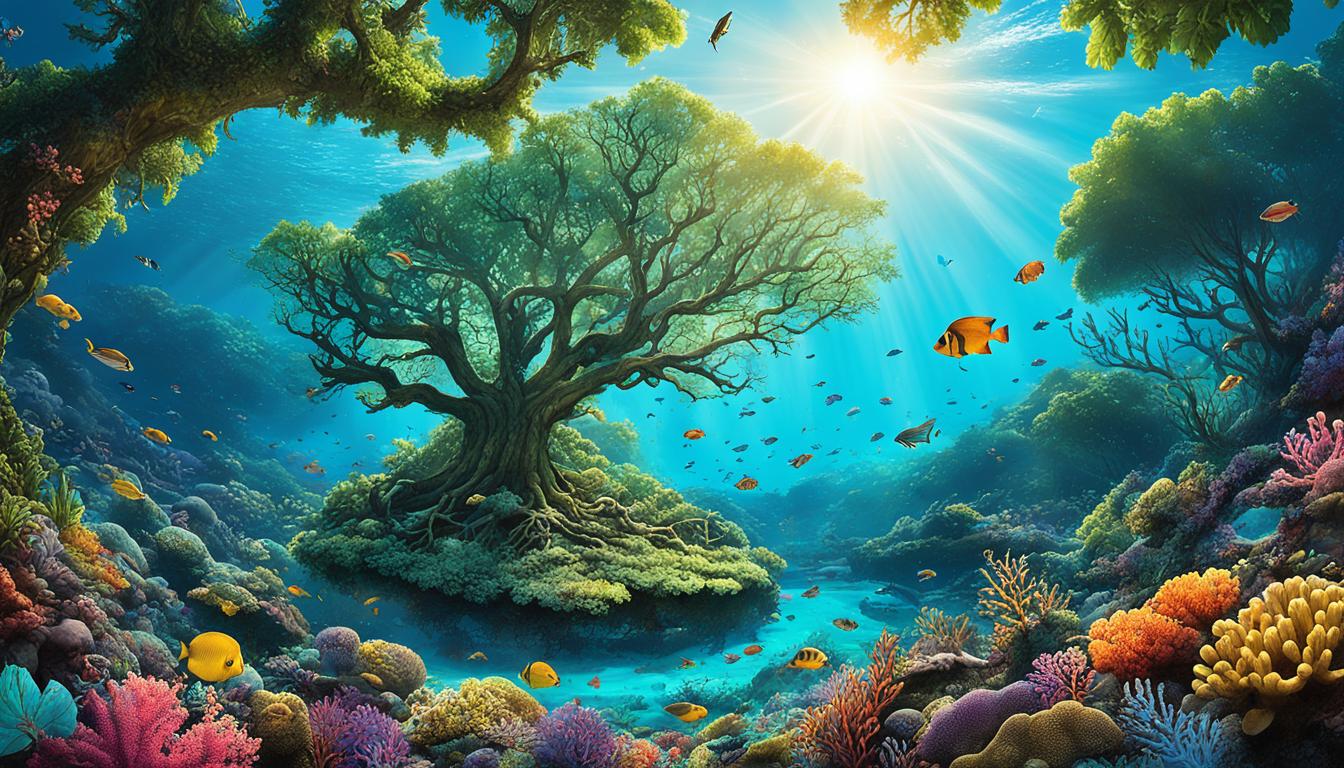


















Post comments (0)